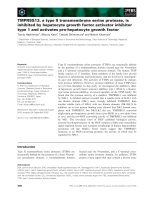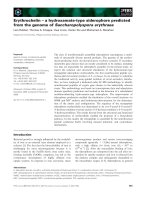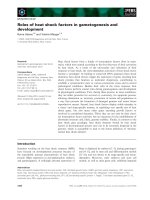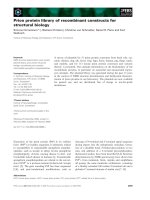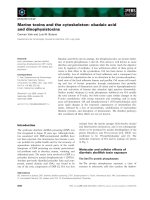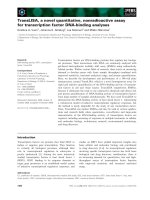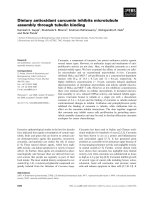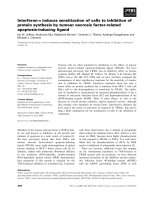Tài liệu Báo cáo khoa học: "GPSM: A GENERALIZED PROBABILISTIC SEMANTIC MODEL FOR AMBIGUITY RESOLUTION" pptx
Bạn đang xem bản rút gọn của tài liệu. Xem và tải ngay bản đầy đủ của tài liệu tại đây (645.75 KB, 8 trang )
GPSM: A GENERALIZED PROBABILISTIC
SEMANTIC MODEL FOR AMBIGUITY RESOLUTION
tJing-Shin Chang, *Yih-Fen Luo and tKeh-Yih Su
tDepartment of Electrical Engineering
National Tsing Hua University
Hsinchu, TAIWAN 30043, R.O.C.
tEmail:
,
*Behavior Design Corporation
No. 28, 2F, R&D Road II, Science-Based Industrial Park
Hsinchu, TAIWAN 30077, R.O.C.
ABSTRACT
In natural language processing, ambiguity res-
olution is a central issue, and can be regarded
as a preference assignment problem. In this
paper, a Generalized Probabilistic Semantic
Model (GPSM) is proposed for preference
computation. An effective semantic tagging
procedure is proposed for tagging semantic
features. A semantic score function is de-
rived based on a score function, which inte-
grates lexical, syntactic and semantic prefer-
ence under a uniform formulation. The se-
mantic score measure shows substantial im-
provement in structural disambiguation over
a syntax-based approach.
1. Introduction
In a large natural language processing system,
such as a machine translation system (MTS), am-
biguity resolution is a critical problem. Various
rule-based and probabilistic approaches had been
proposed to resolve various kinds of ambiguity
problems on a case-by-case basis.
In rule-based systems, a large number of rules
are used to specify linguistic constraints for re-
solving ambiguity. Any parse that violates the se-
mantic constraints is regarded as ungrammatical
and rejected. Unfortunately, because every "rule"
tends to have exception and uncertainty, and ill-
formedness has significant contribution to the er-
ror rate of a large practical system, such "hard
rejection" approaches fail to deal with these situa-
tions. A better way is to find all possible interpre-
tations and place emphases on preference, rather
than weU-formedness (e.g., [Wilks 83].) However,
most of the known approaches for giving prefer-
ence depend heavily on heuristics such as counting
the number of constraint satisfactions. Therefore,
most such preference measures can not be objec-
tively justified. Moreover, it is hard and cosily
to acquire, verify and maintain the consistency of
the large fine-grained rule base by hand.
Probabilistic approaches greatly relieve the
knowledge acquisition problem because they are
usually trainable, consistent and easy to meet cer-
tain optimum criteria. They can also provide
more objective preference measures for "soft re-
jection." Hence, they are attractive for a large sys-
tem. The current probabilistic approaches have a
wide coverage including lexical analysis [DeRose
88, Church 88], syntactic analysis [Garside 87,
Fujisaki 89, Su 88, 89, 91b], restricted semantic
analysis [Church 89, Liu 89, 90], and experimental
translation systems [Brown 90]. However, there
is still no integrated approach for modeling the
joint effects of lexical, syntactic and semantic in-
formation on preference evaluation.
A generalized probabilistic semantic model
(GPSM) will be proposed in this paper to over-
come the above problems. In particular, an in-
tegrated formulation for lexical, syntactic and se-
mantic knowledge will be used to derive the se-
mantic score for semantic preference evaluation.
Application of the model to structural disam-
177
biguation is investigated. Preliminary experiments
show about 10%-14% improvement of the seman-
tic score measure over a model that uses syntactic
information only.
2. Preference Assignment Using
Score Function
In general, a particular semantic interpretation of
a sentence can be characterized by a set of lexical
categories (or parts of speech), a syntactic struc-
ture, and the semantic annotations associated with
it. Among the-various interpretations of a sen-
tence, the best choice should be the most probable
semantic interpretation for the given input words.
In other words, the interpretation that maximizes
the following score function [Su 88, 89, 91b] or
analysis score [Chen 91] is preferred:
Score (Semi, Sgnj, Lexk, Words)
P (Semi, Synj, LezklWords)
= P (SemilSynj, Lexk, Words)
× P (Syn I ILexk, Words)
x
P (LexklWords)
(1)
(semantic score)
(syntactic
score)
(lexical score)
where (Lex,, Synj, Semi) refers to the kth set of
lexical categories, the jth
syntactic structure
and
the ith set of semantic annotations for the input
Words. The three component functions are re-
ferred to as semantic score (Ssem), syntactic score
(Ssyn) and lexical score (Stex), respectively. The
global preference measure will be referred to as
compositional score or simply as score. In partic-
ular, the semantic score accounts for the semantic
preference on a given set of lexical categories and
a particular syntactic structure for the sentence.
Various formulation for the lexical score and syn-
tactic score had been studied extensively in our
previous works [Su 88, 89, 91b, Chiang 92] and
other literatures. Hence, we will concentrate on
the
formulation for semantic score.
3. Semantic Tagging
Canonical Form of Semantic
Representation
Given the formulation in Eqn. (1), first we will
show how to extract the abstract objects (Semi,
Synj, LexD from a semantic representation. In
general, a particular interpretation of a sentence
can be
represented
by an annotated
syntax
tree
(AST), which is a syntax tree annotated with fea-
ture structures in the tree nodes. Figure 1 shows
an example of AST. The annotated version of a
node A is denoted as A = A
[fa]
in the figure,
where fA is the feature structure associated with
node A. Because an AST preserves both syntactic
and semantic information, it can be converted to
other deep structure representations easily. There-
fore, without lose of generality, the AST represen-
tation will be used as the canonical form of seman-
tic representation for preference evaluation. The
techniques used here, of course, can be applied to
other deep structure representations as well.
A[~]
// <
B[fB] C[fc]
D[fD] E[fE] F[fF] G[fc]
C I
C2 C 3 C4
(wl) (w2) (w3) (w4)
Ls={A }
L7={B, C }
L~={B, F, G }
Ls={B, F,c4}
L4={B, c3, c4}
L3={D,E ,c3,ca}
L2={D, c2, c3, c4}
L1 ={Cl, C2, C3, C4 }
Figure 1.
Annotated Syntax Tree
(AST) and Phrase Levels (PL).
The hierarchical AST can be represented by
a set of phrase levels, such as L] through L8 in
Figure 1. Formally, a phrase level (PL) is a set
of symbols corresponding to a sententialform of
the sentence. The phrase levels in Figure 1 are
derived from a sequence of rightmost derivations,
which is commonly used in an LR parsing mech-
anism. For example, 1-,5 and L4 correspond to the
rightmost derivation B F Ca ~+ B c3 c4. Note
rm
that the first phrase level L] consists of all lexical
categories cl cn of the terminal words (wl
w,,). A phrase level with each symbol annotated
with its feature structure is called an annotated
phrase level (APL). The i-th APL is denoted as
Fi. For example, L5 in Figure 1 has an annotated
phrase level F5 = {B [fB], F [fF], c4 [fc,]} as its
178
counterpart, where
fc,
is the atomic feature of the
lexical category
c4,
which comes from the lexical
item of the
4th
word
w4. With the
above nota-
tions, the score function can be re-formulated as
follows:
Score (Semi, Synj , Lexk, Words)
- P (FT, L 7, c~
I,o7)
n n
= P (r~ n IL~ n , c 1 , wl )
x P(LT'Ic , wD
x P (c, [w 1 )
(2)
(semantic score)
(syntactic score)
(lexical score)
where c]" (a short form for {cl c,,}) is the
kth set of lexical categories (Lexk), /-,1" ({L]
Lr,,}) is the jth syntactic structure
(Synj),
and rl m
({F1 Fro}) is the ith set of semantic annotations
(Semi)
for the input words wl" ({wl wn}). A
good encoding scheme for the Fi's will allow us
to take semantic information into account with-
out using redundant information. Hence, we will
show how to annotate a syntax tree so that various
interpretations can be characterized differently.
Semantic Tagging
A popular linguistic approach to annotate a tree
is to use a unification-based mechanism. How-
ever, many information irrelevant to disambigua-
tion might be included. An effective encod-
ing scheme should be simple yet can preserve
most
discrimination information
for disambigua-
tion. Such an encoding scheme can be ac-
complished by associating each phrase struc-
ture
rule A + X1X2 XM
with a
head list
(Xi,,Xi, XiM). The
head list is formed by
arranging the children nodes
(X1,X2, ,XM)
in
descending
order of importance to the compo-
sitional semantics of their mother node A. For this
reason,
Xi~, Xi~ and Xi,
are called the
primary,
secondary and the j-th heads
of A, respectively.
The compositional semantic features of the mother
node A can be represented as an ordered list of the
feature structures of its children, where the order
is the same as in the head list. For example, for
S ~ NP VP, we have a head list (VP, NP), be-
cause VP is the (primary) head of the sentence.
When composing the compositional semantics of
S, the features of VP and NP will be placed in
the first and second slots of the feature structure
of S, respectively.
Because not all children and all features in
a feature structure am equally significant for dis-
ambiguation, it is not really necessary to annotate
a node with the feature
structures
of
all
its chil-
dren. Instead, only the most important N chil-
dren of a node is needed in characterizing the
node, and only the most
discriminative
feature of
a child is needed to be passed to its mother node.
In other words, an N-dimensional feature vector,
called a semantic N-tuple,
could be used to char-
acterize a node without losing much information
for disambiguation. The
first
feature in the se-
mantic N-tuple comes from the
primary
head, and
is thus called the
head feature
of the semantic N-
tuple. The other features come from the other
children in the order of the head list. (Compare
these notions with the linguistic sense of
head and
head feature.)
An annotated node can thus be
approximated as
A ,~ A(fl,f2,
,fN), where
fj = HeadFeature X~7~,~)
is the (primary)
head
feature
of its
j-th
head (i.e.,
Xij) in the
head list.
Non-head features of a child node
Xij
will not be
percolated up to its mother node. The head fea-
ture of ~ itself, in this case, is fx. For a
terminal
node, the head feature will be the
semantic tag
of
the corresponding lexical item; other features in
the N-tuple will be tagged as ~b (NULL).
Figure 2 shows two possible annotated syn-
tax trees for the sentence " saw the boy in
the
park."
For instance, the "loc(ation)" feature
of "park" is percolated to its mother NP node
as the head feature; it then serves as the sec-
ondary head feature of its grandmother node PP,
because the NP node is the secondary head of
PP. Similarly, the VP node in the left tree is an-
notated as VP(sta,anim) according to its primary
head saw(sta,q~) and secondary head NP(anim,in).
The VP(sta,in) node in the fight tree is tagged dif-
ferently, which reflects different attachment pref-
erence of the prepositional phrase.
By this simple mechanism, the major charac-
teristics of the children, namely the head features,
can be percolated to higher syntactic levels, and
179
sta: stative verb
S S def." definite article
.~.~~~. loc: location
anim: animate
°t(a-hlLz-h2) ~~(~-hl,~-h2)
ot(¢X-hl~t~sta,in~ _
~(~ h~,~-h~)
NP~ f~- ~)saw(:ta:(~d)e~:,~)in(in~,def)
the(def'~,¢) boy(-y~(~m,¢)in(in,~) ~ the(def#)/#)~p~par~Nk(loc,¢)
the(def,t~) park(loc#)
Figure 2. Ambiguous PP attachment patterns annotated with semantic 2-tuples.
their correlation and dependency can be taken into
account in preference evaluation even if they are
far apart. In this way, different interpretations will
be tagged differently. The preference on a partic-
ular interpretation can thus be evaluated from the
distribution of the annotated syntax trees. Based
on the above semantic tagging scheme, a
seman-
tic score
will be proposed to evaluate the seman-
tic preference on various interpretations for a sen-
tence. Its performance improvement over
syntac-
tic score
[Su 88, 89, 91b] will be investigated.
Consequently, a brief review of the syntactic score
evaluation method is given before going into de-
tails of the semantic score model. (See the cited
references for details.)
4. Syntactic Score
According to Eqn. (2), the
syntactic score can be
formulated as follows [Su 88, 89, 91b]:
S,y,, =_ P(SynilLeZk,W'~) = P(L'~lc'~,w~)
(3)
fti
= HP(LtlL~-',c~,w~)
1=2
1-I
P
(L, IL',-')
~" II P(L'IL'-')
= HP({o~t, A,, /3,} I{o,,, ~',})
180
where
at, fit
are the left context and right context
under which the derivation
At =~ X1X2
XM
occurs. (Assume that
Lt = {at, At,fit} and
LI-1 = {at,X1,"" ,XM,fil}.)
If L left context
symbols in al and R right context symbols in fit
are consulted to evaluate the syntactic score, it is
said to operate in
LLRR mode
of operation. When
the context is ignored, such an
LoRo
mode of oper-
ation reduces to a stochastic
context-free
grammar.
To avoid the
normalization problem
[Su 91b]
arisen from different number of transition prob-
abilities for different syntax trees, an alternative
formulation of the syntactic score is to evaluate
the transition probabilities between configuration
changes of the parser. For instance, the config-
uration of an LR parser is defined by its stack
contents and input buffer. For the AST in Figure
1, the parser configurations after the read of cl,
c2, c3, c4
and $ (end-of-sentence) are equivalent
to L1,
L2, L4, 1 5 and Ls,
respectively. Therefore,
the syntactic score can be approximated as [Su
89, 91b]:
S, vn ~ P(Ls, LT'" L2IL,) (4)
P(LslL~) x P(LsIL4) x P(L41L2) x P(L21L1)
In this way, the number of transition probabilities
in the syntactic scores of all AST's will be kept
the same as the sentence length.
5. Semantic Score
Semantic score
evaluation is similar to syntactic
score evaluation. From Eqn. (2), we have the
following semantic model for
semantic score:
S, em (Semi, Synj , Lex~:, Words)
= p (p~n ILT, c~, w~)
m
I 1 ra n n
= I"[P(F, IF1 ,L1 ,Cl,Wl)
(5)
1=2
1"I P(r, lr,_l)
=
where 3~j am the semantic tags from the chil-
dren of
A1.
For example, we have terms
like e(VP(sta, anim) [ a, VP ~- v NP,fl) and
P(VP(sta, in) la, Ve~v NP PP,fl),respec-
fively, for the left and right trees in Figure 2. The
annotations of the context am ignored in evalu-
ating Eqn. (6) due to the assumption of seman-
tics compositionality. The operation mode will be
called LLRR+Alv,
where N is the dimension of the
N-tuple, and the subscript L (or R) refers to the
size of the context window. With an appropriate
N, the score will provide sufficient discrimination
power for general disambiguation problem with-
out resorting to full-blown semantic analysis.
where
At = At (ft,l,fln, ,fuv)
is the anno-
tated version of
At,
whose semantic N-tuple is
(fl,1, fl,2,-", ft,N), and 57, fit are the annotated
context symbols. Only Ft.1 is assumed to be sig-
nificant for the transition to Ft in the last equa-
tion, because all required information is assumed
to have been percolated to Ft-j through semantics
composition.
Each term in Eqn. (5) can be interpreted as
the probability
thatAt
is annotated with the partic-
ular set of head features (fs,1,
ft,2, , fI,N),
given
that X1 XM are reduced to
At
in the context of
a7 and fit.
So it can be interpreted informally as
P(At (fl,1, ft,2, . . . , fz ~v) I Ai ~ X1. . . XM ,
in the context of ~-7, fit ). It corresponds to the se-
mantic preference assigned to the annotated node
A t" Since
(11,1, fl,~,"" ft,N) are the
head features
from various heads of the substructures of A, each
term reflects the
feature co-occurrence
preference
among these heads. Furthermore, the heads could
be very far apart. This is different from most
simple Markov models, which can deal with local
constraints only. Hence, such a formulation well
characterizes long distance dependency among the
heads, and provides a simple mechanism to incor-
porate the feature co-occurrence preference among
them. For the semantic N-tuple model, the seman-
tic score can thus be expressed as follows:
S~.~ (6)
m
"~ I-[ P ( A* (ft,,, f,,2 " " " ft,N) la,,A,
, Xl "
" gM,/~l)
l=2
181
6. Major Categories and
Semantic Features
As mentioned before, not all constituents are
equally important for disambiguation. For in-
stance,
head words are
usually more important
than modifiers
in determining the compositional
semantic features of their mother node. There is
also lots of redundancy in a sentence. For in-
stance,
"saw boy in park"
is equally recogniz-
able as "saw the boy in the park." Therefore,
only a few categories, including
verbs, nouns, ad-
jectives, prepositions and adverbs
and their pro-
jections (NP, VP, AP, PP, ADVP), are used to
carry semantic features for disambiguation. These
categories are roughly equivalent to the
major cat-
egories
in linguistic theory [Sells 85] with the in-
clusion of
adverbs as the
only difference.
The semantic feature of each major category
is encoded with a set of
semantic tags
that well
describes each category. A few rules of thumb
are used to select the semantic tags. In particular,
semantic features that can discriminate different
linguistic behavior from different possible seman-
tic
N-tuples
are preferred as the semantic tags.
With these heuristics in mind, the verbs, nouns,
adjectives, adverbs and prepositions are divided
into 22, 30, 14, 10 and 28 classes, respectively.
For example, the nouns are divided into "human,"
"plant," "time," "space," and so on. These seman-
tic classes come from a number of sources and
the semantic attribute hierarchy of the ArchTran
MTS [Su 90, Chen 91].
Table 1. Close Test of Semantic Score
7. Test and Analysis
The semantic N-tuple model is used to test the
improvement of the semantic score over syntactic
score in structure disambiguation. Eqn. (3) is
adopted to evaluate the syntactic score in L2RI
mode of operation. The semantic score is derived
from Eqn. (6) in L2R~ +AN mode, for N = 1, 2,
3, 4, where N is the dimension of the semantic
S-tuple.
A total of 1000 sentences (including 3 un-
ambiguous ones) are randomly selected from 14
computer manuals for training or testing. They
are divided into 10 parts; each part contains 100
sentences. In close tests, 9 parts are used both
as the training set and the testing set. In open
tests, the rotation estimation approach [Devijver
82] is adopted to estimate the open test perfor-
mance. This means to iteratively test one part of
the sentences while using the remaining parts as
the training set. The overall performance is then
estimated as the average performance of the 10
iterations.
The performance is evaluated in terms of Top-
N recognition rate (TNRR), which is defined as
the fraction of the test sentences whose preferred
interpretation is successfully ranked in the first
N candidates. Table 1 shows the simulation re-
suits of close tests. Table 2 shows partial results
for open tests (up to rank 5.) The recognition
rates achieved by considering syntactic score only
and semantic score only are shown in the tables.
(L2RI+A3 and L2RI+A4 performance are the same
as L2R~+A2 in the present test environment. So
they are not shown in the tables.) Since each sen-
tence has about 70-75 ambiguous constructs on
the average, the task perplexity of the current dis-
ambiguation task is high.
Score
Rank
1
2
3
4
5
13
18
Syntax Semantics Semantics
(L2R1) (L2RI+A1) (L2RI+A2)
Count TNRR
(%)
781
101
9
5
Count TNRR
(%)
87.07 872
98.33 20
99.33 5
99.89
100.00
97.21 866
99.44 24
100.00 4
2
1
Count TNRR
(%)
96.54
99.22
99.67
99.89
100.00
DataBase: 900 Sentences
Test Set: 897 Sentences
Total Number of Ambiguous Trees = 63233
(*) TNRR: Top-N Recognition Rate
Table 2. Open Test of Semantic Score
Score Syntax
(L2R1)
Rank Count TNRR
(%)
1 430 43.13
2 232 66A0
3 94 75.83
4 80 83.85
5 35 87.36
Semantics
(L2RI+A1)
Count TNRR!
(%)
569 57.07
163 73.42
90 82.45
50 87.46
22 89.67
Semantics
(L2RI+A2)
Count TNRR
(%)
578 57.97
167 74.72
75 82.25
49 87.16
28 89.97
DataBase: 900 Sentences (+)
Test Set: 997 Sentences (++)
Total Number of Ambiguous Trees = 75339
(+) DataBase : effective database size for rotation
estimation
(++) Test Set : all test sentences participating the
rotation estimation test
182
The close test Top-1 performance (Table 1)
for
syntactic
score (87%) is quite satisfactory.
When
semantic
score is taken into account, sub-
stantial improvement in recognition rate can be
observed further (97%). This shows that the se-
mantic model does provide an effective mecha-
nism for disambiguation. The recognition rates
in open tests, however, are less satisfactory under
the present test environment. The open test per-
formance can be attributed to the small database
size and the estimation error of the parameters
thus introduced. Because the training database is
small with respect to the complexity of the model,
a significant fraction of the probability entries in
the testing set can not be found in the training set.
As a result, the parameters are somewhat "over-
tuned" to the training database, and their values
are less favorable for open tests. Nevertheless,
in both close tests and open tests, the semantic
score model shows substantial improvement over
syntactic score (and hence stochastic context-free
grammar). The improvement is about 10% for
close tests and 14% for open tests.
In general, by using a larger database and bet-
ter robust estimation techniques [Su 91a, Chiang
92], the baseline model can be improved further.
As we had observed from other experiments for
spoken language processing [Su 91a], lexical tag-
ging, and structure disambiguation [chiang 92],
the performance under sparse data condition can
be improved significantly if robust adaptive leam-
ing techniques are used to adjust the initial param-
eters. Interested readers are referred to [Su 91a,
Chiang 92] for more details.
8. Concluding Remarks
In this paper, a
generalized probabilistic seman-
tic model
(GPSM) is proposed to assign
semantic
preference
to ambiguous interpretations. The se-
mantic model for measuring preference is based
on a score function, which takes lexical, syntactic
and semantic information into consideration and
optimizes the joint preference. A simple yet effec-
tive encoding scheme and semantic tagging proce-
dure is proposed to characterize various interpreta-
183
tions in an N dimensional feature space. With this
encoding scheme, one can encode the interpre-
tations with discriminative features, and take the
feature co-occurrence preference among various
constituents into account. Unlike simple Markov
models, long distance dependency can be man-
aged easily in the proposed model. Preliminary
tests show substantial improvement of the seman-
tic score measure over syntactic score measure.
Hence, it shows the possibility to overcome the
ambiguity resolution problem without resorting to
full-blown semantic analysis.
With such a simple, objective and trainable
formulation, it is possible to take high level se-
mantic knowledge into consideration in statistic
sense. It also provides a
systematic
way to con-
struct a disambiguation module for large practical
machine translation systems without much human
intervention; the heavy burden for the linguists to
write fine-grained "rules" can thus be relieved.
REFERENCES
[Brown 90] Brown, P. et al., "A Statistical Ap-
proach to Machine Translation,"
Computational
Linguistics,
vol. 16, no. 2, pp. 79-85, June
1990.
[Chen 91] Chen, S C., J S. Chang, J N. Wang
and K Y. Su, "ArchTran: A Corpus-Based
Statistics-Oriented English-Chinese Machine
Translation System,"
Proceedings of Machine
Translation Summit 11I,
pp. 33-40, Washing-
ton, D.C., USA, July 1-4, 1991.
[Chiang 92] Chiang, T H., Y C. Lin and K Y.
Su, "Syntactic Ambiguity Resolution Using A
Discrimination and Robustness Oriented Adap-
tive Leaming Algorithm", to appear in
Pro-
ceedings of COLING-92,
14th Int. Conference
on Computational Linguistics, Nantes, France,
20-28 July, 1992.
[Church 88] Church, K., "A Stochastic Parts Pro-
gram and Noun Phrase Parser for Unrestricted
Text,"
ACL Proc. 2nd Conf. on Applied Natu-
ral Language Processing,
pp. 136-143, Austin,
Texas, USA, 9-12 Feb. 1988.
[Church 89] Church, K. and P. Hanks, "Word As-
sociation Norms, Mutual Information, and Lex-
icography,"
Proc. 27th Annual Meeting of the
ACL,
pp. 76-83, University of British Colum-
bia, Vancouver, British Columbia, Canada, 26-
29 June 1989.
[DeRose 88] DeRose, SteverL J., "Grammatical
Category Disambiguation by Statistical Opti-
mization,"
Computational Linguistics,
vol. 14,
no. 1, pp. 31-39, 1988.
[Devijver 82] Devijver, P.A., and J. Kittler,
Pattern Recognition: A Statistical Approach,
Prentice-Hall, London, 1982.
[Fujisaki 89] Fujisaki, T., F. Jelinek, J. Cocke, E.
Black and T. Nishino, "A Probabilistic Parsing
Method for Sentence Disambiguation,"
Proc. of
Int. Workshop on Parsing Technologies
(IWPT-
89), pp. 85-94, CMU, Pittsburgh, PA, U.S.A.,
28-31 August 1989.
[Garside 87] Garside, Roger, Geoffrey Leech and
Geoffrey Sampson (eds.),
The Computational
Analysis of English: A Corpus-Based Approach,
Longman Inc., New York, 1987.
[Liu 89] Liu, C L.,
On the Resolution of English
PP Attachment Problem with a Probabilistic Se-
mantic Model,
Master Thesis, National Tsing
Hua University, Hsinchu, TAIWAN, R.O.C.,
1989.
[Liu 90] Liu, C L, J S. Chang and K Y. Su,
"The Semantic Score Approach to the Disam-
biguation of PP Attachment Problem,"
Proc. of
• ROCLING-III,
pp. 253-270, Taipei, R.O.C.,
September 1990.
[Sells 85] Sells, Peter,
Lectures On Con-
temporary Syntactic Theories: An Introduc-
tion to Government-Binding Theory, General-
ized Phrase Structure Grammar, and Lexical-
Functional Grammar,
CSLI Lecture Notes
Number 3, Center for the Study of Language
and Information, Leland Stanford Junior Uni-
versity., 1985.
[Su 88] Su, K Y. and J S. Chang, "Semantic and
Syntactic Aspects of Score Function,"
Proc. of
COLING-88,
vol. 2, pp. 642-644, 12th Int.
Conf. on Computational Linguistics, Budapest,
Hungary, 22-27 August 1988.
[Su 89] Su, K Y., J N. Wang, M H. Su and J S.
Chang, "A Sequential Truncation Parsing Algo-
rithm Based on the Score Function,"
Proc. of
Int. Workshop on Parsing Technologies
(IWPT-
89), pp. 95-104, CMU, Pittsburgh, PA, U.S.A.,
28-31 August 1989.
[Su 90] Su, K Y. and J S. Chang, "Some Key
Issues in Designing MT Systems,"
Machine
Translation,
vol. 5, no. 4, pp. 265-300, 1990.
[Su 91a] Su, K Y., and C H. Lee, "Robusmess
and Discrimination Oriented Speech Recog-
nition Using Weighted HMM and Subspace
Projection Approach,"
Proceedings of IEEE
ICASSP-91,
vol. 1, pp. 541-544, Toronto, On-
tario, Canada. May 14-17, 1991.
[Su 91b] Su, K Y., J N. Wang, M H. Su, and J
S. Chang, "GLR Parsing with Scoring". In M.
Tomita (ed.),
Generalized LR Parsing,
Chapter
7, pp. 93-112, Kluwer Academic Publishers,
1991.
[Wilks 83] Wilks, Y. A., "Preference Semantics,
Ul-Formedness, and Metaphor,"
AJCL,
vol. 9,
no. 3-4, pp. 178 - 187, July - Dec. 1983.
184
